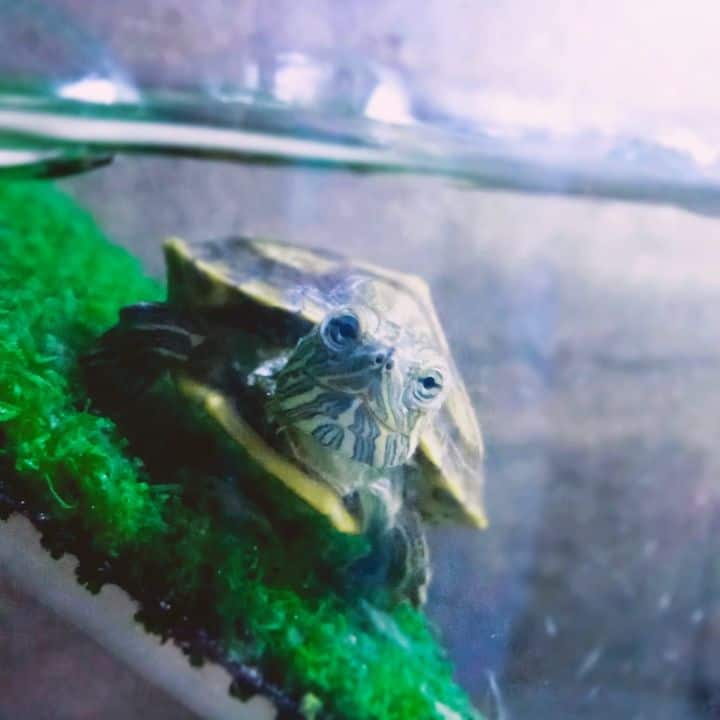Tags:
What Is Turtle Floating Syndrome? [Turtle Buoyancy Problems]


fact checked & review by
Dr. Partho Kumar Shaha
Veterinarian (DVM)
The information is current and up-to-date in accordance with the latest veterinarian research.
Trust me. You would not like to see your turtle float in the tank. Now do not say that your turtle floats in the water all the time. For your kind information, the pet is swimming. If you catch your turtle float, it might have a bigger issue.
Floating syndrome is a physical condition that prevents turtles from diving underwater. This condition can occur due to gas accumulation in the intestines, respiratory illness, or lung deformation. Fortunately, this condition is curable. Not treating this condition can lead to permanent damage and premature death.
I have talked about floating syndrome, visible symptoms, and probable treatments in the article below.
Key Takeaways
- Two common causes of floating syndrome are respiratory illness and gastrointestinal issues.
- The buoyancy effect due to intestine gas buildup is less severe.
- Push the turtle underwater a bit and see if it bobs up right away. If yes, immediately take the pet to a vet for checkup and treatment.
Turtle Floating Syndrome: The Buoyancy Problem
Experts often tag turtle floating syndrome as a silent killer. It is basically seen in sea turtles. But of course, the buoyancy problem is also common in aquatic domestic and wild turtles.
Ingestion of plastic and marine debris is the main reason for the floating syndrome in sea turtles. What happens is the polymer residuals or inappropriate food block the gastrointestinal tract in turtles, building up gas. Hence, the creatures face the buoyancy effect.
As said, your home aquatic turtle or the one living in the wild can also experience this gas accumulation. Therefore, you can spot them floating in the water, too.
Experts say floating syndrome occurs mainly due to the gas build up in the intestine. However, sometimes, it is the respiratory illness that is causing the buoyancy effect.
A 2022 study looked at floating disease in green sea turtles and found it was associated with debilitating fibropapillomatosis tumors. They concluded floating was likely a consequence of impaired diving ability due to tumor burden.
What Causes Buoyancy Problems In Turtles?
As mentioned, we can blame 2 causes for the floating syndrome in turtles,
- Trapped intracolonic gas
- Respiratory illness
Here is the information on causes of turtle floating syndrome organized into a table:
| Cause | Details |
|---|---|
| Trapped Intracolonic Gas | Gas accumulation in gastrointestinal tract due to intestinal blockage from partially digested food rotting and producing gas. Can also be caused by ingesting new food items, marine debris (for sea turtles), plastic pieces, irregular bowel movements, medications. |
| Respiratory Illness | Direct infection of the lungs caused by low temperature, poor UV lighting, malnutrition, dirty enclosure. Can lead to pneumonia with fluid-filled lungs. |
| Addition of new food item | Can cause intestinal blockage leading to gas buildup |
| Ingestion of marine debris (sea turtles) | Can cause intestinal blockage leading to gas buildup |
| Ingestion of plastic | Can cause intestinal blockage leading to gas buildup |
| Irregular bowel movements | Can cause intestinal blockage leading to gas buildup |
| Medication ingestion | Can cause intestinal blockage leading to gas buildup |
| Low temperature | Weakens immune system allowing respiratory infection to take hold |
| Poor UV lighting | Weakens immune system allowing respiratory infection to take hold |
| Malnutrition | Weakens immune system allowing respiratory infection to take hold |
| Dirty enclosure | Allows bacteria/fungi to thrive and cause respiratory infection |
| Pneumocoelom | Internal trauma causing lung tears and free gas in body cavity |
| Fibropapillomas (tumors) | Adds density to one side of lungs affecting buoyancy |
| Lung deformation | Abnormal lung structure like enlargement affects buoyancy |
Let’s talk about these problems in detail.
1. Trapped Intracoelmic Gas
Gas accumulation in the gastrointestinal tract is a potential reason why turtles suffer from the floating syndrome. But why is there intestinal gas build up in their system?
Well, several things can lead to an intestine blockage, which hampers the digestion process. If the meals are only half-broken, they will start rotting and produce a gas. Not every time turtles can release this intestinal gas. As a result, they feel bloated and bounce back whenever they take a dive.
I have found multiple causes responsible for the trapped intracoelmic gas in the turtle’s body. For example,
- Addition of a new item to the meal
- Munching on marine debris (This is for sea turtles)
- Ingesting plastic pieces
- Obscure bowel movement
- Consumption of a medicine
A 2021 case study reported on a green sea turtle found floating lethargically off the coast of Florida, unable to dive due to advanced fibropapillomatosis. Necropsy confirmed floating disease as the cause of impaired diving ability.
2. Respiratory Illness
Another reason for the floating syndrome is a respiratory infection. This disease directly affects the lungs. In worse cases, the respiratory illness turns into pneumonia, and the lungs get filled with fluid. It throws the sick pet off the balance, making it float in the water.
Do you know what leads to respiratory infection in reptiles? We can blame 4 factors responsible for this disease. Such as,
- Low temperature
- Poor UV settings
- Malnutrition
- Dirty enclosure
Cold temperature, insufficient UVB rays, and malnutrition usually lower the immunity of a turtle. As a result, the pet might easily fall victim to an infectious attack.
Again, a filthy habitat crawls with germs and bacteria all the time. If you raise your turtle in a dirty tank, a bacterial or fungal attack on the lungs is no surprise.
Any of these two scenarios can lead to respiratory illness in the turtles, making them float instead of swimming.
3. Other Probable Reasons
While researching, I got to know 3 less common causes of floating syndrome,
- Pneumocoelom occurs due to internal trauma. It can cause lung tears and generate free gas in the body cavity. The free gas compresses viscera, including the lungs. Such pressure generation also leads to buoyancy effects.
- Fibropapillomas, an internal tumor, can also cause buoyancy issues as they add density to one side of the lungs.
- Deformation of the lungs, for example, saccular lung expansion and enlargement of one lung, is also responsible for floating syndrome in turtles.
Dangers Of Floating Syndrome In Turtles
We often do not understand the dark side of buoyancy problems in our pets. See, turtles love to swim underwater. In the wild and ocean, these creatures go deep to hunt down their prey and collect their daily meals.
But what happens when a turtle is suffering from floating syndrome? They can not go underwater. In fact, some turtles will not be able to swim.
Now swimming or going underwater will make the turtles crazy and frustrated. You can sense the restlessness in their behavior.
Not to mention that wild turtles can starve to death because of the floating syndrome. I mean how would the creatures catch meals when they can not dive?
In March 2017, a green sea turtle was rescued from Florida beach who was struggling to get in the water. Further investigation revealed that the marine creature had a buoyancy problem because it had ingested plastic.
As per another article, turtles with floating syndrome are more likely to be blown ashore. They also fall victim to fishing gear entanglement and get caught. Many of these sick turtles die because of trauma from boat collisions.
Here is a table listing common turtle breeds and their relative risk levels for developing floating syndrome:
| Turtle Breed | Floating Syndrome Risk Level | Additional Details |
|---|---|---|
| Red-eared Slider | Medium | Very common pet turtle but not especially prone to floating syndrome. |
| Painted Turtle | Medium-High | More likely than sliders due to habitat and dietary requirements. |
| Snapping Turtle | Low | Strong swimmers less impacted unless illness/injury occurs. |
| Musk Turtle | Medium | Can be susceptible if temperatures drop too low in captive setting. |
| Russian Tortoise | Low | Strict herbivore with low risk unless metabolic bone disease develops. |
| Box Turtle | Medium | More susceptible than other tortoises due to enclosure/temperature needs. |
| Green Sea Turtle | High | In wild, fibropapillomatosis is a big concern leading to floating. |
| Loggerhead Sea Turtle | High | Same risks as greens from tumors, ingesting plastic, boat strikes, etc. |
| Leatherback Sea Turtle | High | Face threats to buoyancy from marine debris consumption and injuries. |
A 2020 review article discussed floating disease in sea turtles and its association with debilitating tumors, wounds, and other illnesses that prevent normal submerging and swimming.
How To Diagnose A Turtle Having Buoyancy Effect?
Well, you will know it when you see a turtle float. If you feel confused, push the reptile a bit underwater. If it bobs up on the surface immediately, it is suffering from the floating syndrome.
Again, you might catch the turtle swimming upside down or sideways. Generally, sideways swimming indicates a respiratory illness and upside down loop swimming refers to a gastrointestinal issue.
There are other ways of spotting a turtle with respiratory sickness, too. For example, the ill turtle will show the below symptoms,
- Discharge coming from mouth, nose, and eyes
- Teary eyes
- Swollen and puffy eyes
- Wheezing and coughing
- Sneezing
- Fatigue
- Fear of swimming
- Frequent basking
- Trouble breathing
- Loss of appetite
- Weight loss
Here is a table outlining the visible symptoms of turtle floating syndrome and recommended vet visit timelines:
| Symptom | Description | Recommended Timeline to See Vet |
|---|---|---|
| Floating or inability to dive | Turtle floats at surface of water rather than swimming down | Within 24 hours |
| Lethargy | Decreased activity and responsiveness | Within 24 hours |
| Bubbles from mouth/nose | Gas escaping respiratory or digestive tract | Within 12 hours |
| Cloudy eyes | Sign of respiratory infection | Within 12 hours |
| Mucus discharge | Nasal or ocular discharge from infection | Within 12 hours |
| Off-balance swimming | Tilting to one side when swimming | Within 48 hours |
| Loss of appetite | Refusal to eat | Within 48 hours |
| Frequent basking | Respiratory distress causes more time out of water | Within 48 hours |
| Soft or puffy shell | Sign of organ swelling from infection | Within 24 hours |
| Coughing or sneezing | Effort to clear lungs of mucus or fluid | Within 12 hours |
Is Floating Syndrome Curable In Turtles?
I think you can imagine how terrible the buoyancy effect is in turtles. Of course, we can not overlook this physical condition. It can turn into a deadly disease in no time.
So, I recommend you rush to the vet if your pets are diagnosed with floating syndrome. The professional will suggest some medication along with lifestyle changes. The helpful treatment tips as follows,
- I always suggest keeping a daily diary of your turtles. It helps you track everything that is happening with the pets. If you have taken down the notes, just go through them. Notice the changes and find out the probable causes.
- Avoid any new item you have introduced to the meals recently. In many cases, turtles find it hard to digest some food, which causes the gas to build up.
- Medications can be responsible for the bloating, too. Run it with the vet first before removing any meds from the list.
- You can influence the bowel movement of the turtles by offering them lukewarm water. Also, a comfortable and safe environment is enough to restore their bowel routine. Thus, the floating syndrome will be gone in days.
- In marine turtles, the rescue centers come forward for help. The voulenteer vets remove the plastics or debris by performing surgeries. As the turtles are cured, they can swim again.
- A low temperature is a curse for turtles. The ideal water and basking temperatures are 70F to 80F and 85F to 95F, respectively. Proper temperature setting is necessary to treat and cure respiratory illness.
- Install quality heating lamps and UV bulbs in the enclosure. Both are significant in boosting the immunity of the turtles.
- As I said, improper diet leads to malnutrition and weakness in turtles. A balanced meal is mandatory for the sick turtles. Many owners suggest feeding the sick pets more vegetables and greens.
- Finally, you can not allow your turtles to live in a filthy enclosure. It increases the risk of bacterial or infectious diseases. Follow the ideal cleaning schedule for the turtle tank.
In general, floating syndrome due to trapped gas is not that serious. It is curable naturally unless the turtle has ingested polymer or debris. Why do turtles eat plastic you ask? Well, research has proved that turtles can smell underwater.
In fact, the creatures use their olfactory to find food and mate. Dumped plastic in the water smells like organic greens because of the air and water-borne bacterias on the surface. So, turtles mistake these as meals and devour them with great interest. A turtle with plastic in its system requires surgery or medical supervision to get well.
Bouyancy issue due to respiratory infection is undoubtedly severe. There are reports of death due to this disease. I will strogly suggest you take the sick turtle to a hospital for immediate help.
If the pet does not get around even after one month, the expert will add weight to the other side for balance.
why is my turtle floating on its side?
There are a few reasons why your turtle may be floating on its side:
- Respiratory infection: If your turtle is floating tilted or sideways, it could be a sign of a respiratory infection. Respiratory infections are common in turtles and cause breathing difficulties that result in an inability to stay submerged. In both cases, your turtle is probably suffering from a respiratory infection. And the sideways floating indicates a more severe stage of this illness.
- Shell or limb issues: Issues with the shell such as injuries or deformities, or problems with limbs/joints could prevent the turtle from staying balanced underwater.
- Weakness: General weakness from illness, malnutrition, old age etc. can cause a turtle to float involuntarily.
- Gas buildup: While a floating turtle is a symptom of a serious disease, it may only be caused by the gas accumulated in your turtle. Gas buildup is usually not severe enough on its own to cause sideways floating.
In most cases where a turtle is floating on its side, it indicates an illness such as a respiratory infection that requires veterinary attention. It’s best to take your turtle to an exotic vet for examination and treatment.
do turtles float when they die?
Whether a turtle floats after death depends on a few factors:
Shortly after death, a turtle will usually sink due to loss of muscle control and buoyancy. In general, turtles are not very buoyant and are likely to sink when they die.
As the decomposition process begins, gas builds up in the turtle’s body from bacterial activity. This gas production can cause the turtle’s body to become buoyant enough to float, usually within 24-48 hours of death. As the flesh starts decomposing, gases released during the process make the turtle float to the surface.
Some turtles with heavier shells may still sink even after gas buildup, depending on the balance between shell weight and internal gases.
Environmental factors like water temperature can influence decomposition rate and how quickly the turtle floats.
why is my baby turtle floating?
There are a few common reasons why a baby turtle may be floating:
- Gas buildup – Like adults, babies can float if they have excess gas in their digestive system. This is generally harmless and will pass on its own.
- Respiratory infection – Floating can be a sign of a respiratory infection in babies, similar to adults. Respiratory illnesses are severe for young turtles.
- Shell deformities – Babies are still growing, so floating may indicate shell abnormalities from metabolic bone disease (MBD) which weakens their ability to dive.
- Poor health in general – Floating can be a nonspecific sign something is wrong in babies, like malnutrition, infection, or other illness.
why is my turtle floating upside down?
If your turtle is floating upside down at the surface of the water, it is always a medical emergency that requires immediate veterinary attention. Some key reasons why an upside down floating turtle needs urgent care include:
Respiratory infection: Floating upside down is a classic sign of a lower respiratory infection in turtles. The infection has likely spread to the lungs. Left untreated, it can be fatal within 48 hours.
Pneumonia: Advanced respiratory infections may have caused pneumonia. Turtles are unable to right themselves due to fluid buildup in their lungs. This is considered a very serious condition.
Metabolic bone disease: Floating can sometimes indicate shell abnormalities from MBD that impair buoyancy control. MBD weakens the bones and shell.
Head trauma/injury: Issues like injuries that impact the turtle’s ability to stay balanced underwater can cause upside down floating.
Before You Go…
You might want to know if floating of any kind is a red alert for turtles or not. Well, the answer is no. Sometimes the pets just relax and float around for fun. I have discussed all the possibilities of why a turtle may float in the attached article.

About Author
Muntaseer Rahman started keeping pet turtles back in 2013. He also owns the largest Turtle & Tortoise Facebook community in Bangladesh. These days he is mostly active on Facebook.
Disclaimer
This site is owned and operated by Muntaseer Rahman. TheTurtleHub.com is a participant in the Amazon Services LLC Associates Program, an affiliate advertising program designed to provide a means for sites to earn advertising fees by advertising and linking to Amazon.com. This site also participates in other affiliate programs and is compensated for referring traffic and business to these companies.






